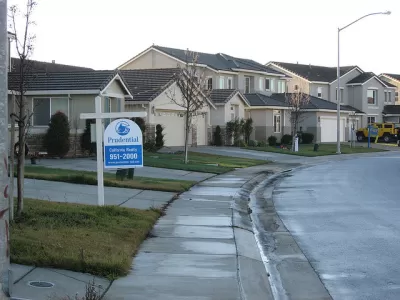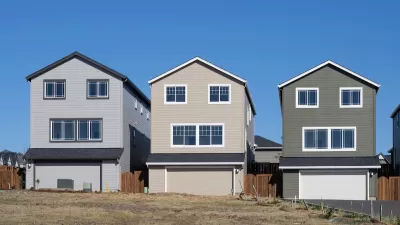Arnab Chakraborty of the University of Illinois at Urbana-Champaign and Andrew McMillan of the University of Maryland College Park guest blog about a recent article in the Journal of Planning Education and Research.

Communities with a diverse housing stock have long been viewed as an important planning goal. Indeed, housing diversity has been cited as a necessary component of building vibrant communities, with greater social equity and access to employment opportunities (Leccese and McCormick 2000, American Planning Association 2006, Smart Growth America 2016). But do communities with a diverse mix of housing units offer greater stability during a housing market or economic downturn? We explore this issue in our recent article in Journal of Planning Education and Research, "Is Housing Diversity Good for Community Stability?: Evidence from the Housing Crisis." We find that the answer is yes. We also find that it is not sufficient for a city to be diverse as a whole; housing unit diversity matters at the census tract level.
Conventional investment advice asserts that a diverse portfolio lowers investor risk, while economic development theory posits that regions with a diverse mix of industries will be less vulnerable to economic shifts or downturns. Similarly, we hypothesize that a community with a diverse housing mix will experience greater stability during an economic or housing market downturn. Our framing rests on the idea that communities with a diverse housing mix will have more options for residents at a range of income levels. Homebuyers will often have a strong preference to live in a certain community. This may be related to access to employment, schools, or social and family ties. When a community lacks a diverse housing stock, some homebuyers may purchase properties that are beyond their means through a risky mortgage or locate further away from where they would like to be. The resulting increase in housing or transportation cost could increase the risk of default.
We used data on foreclosures and home sales during the housing market downturn and early years of the recovery (2005 to 2010, and 2010 to 2014 respectively) to test the relationship between housing diversity and community stability. In addition, we collected parcel-level zoning data for jurisdictions within 14 metropolitan statistical areas (MSAs). While an MSA's ultimate inclusion in the study was based on where we could collect these data for at least 80% of the region, we aimed to include MSAs from multiple parts of the United States as well as MSAs that were affected differently by the foreclosure crisis.
We employed census housing structure categories (such as single family, 2-4 unit, 5-19 unit) to develop a housing diversity index (HDI) within each tract. This is based on Simpson's Diversity Index, an ecological measure of species diversity. An HDI value of one indicates a completely homogenous census tract whereas an HDI value of zero indicates a completely heterogenous tract. In addition, we calculated an index for diversity in zoned housing units, called Zoning Restrictive Index (ZRI) to consider the intent to create a more diverse housing stock.
These variables allowed us to conduct a series of regressions that tested the relationship between foreclosure and sales rates and the diversity indices as well as various other census-derived population characteristics. We used ordinary least squares and spatial regression models. We found significant connections between housing unit diversity and foreclosure and sales rates across all models, suggesting that communities with less diverse housing experienced both high foreclosure rates during the worst years of the housing downturn (2005 to 2010), as well as higher sales rates during the first few years of the housing market recovery (2010 to 2014). We found less robust results for zoning restrictiveness, suggesting that existing diversity is more influential than zoned diversity with regard to foreclosure and sales rates.
Our findings provide further evidence that communities that “overzone” for high-end single-family units may force residents to purchase a home above their means. This may increase their exposure to foreclosure or at the very least financial precarity, especially in the event of a housing market downturn. There are additional reasons for pursuing housing diversity as an important planning goal through appropriate zoning and other means. For example, recent studies have found that Baby Boomers would prefer to age in place (Farber et al. 2011). If communities lack diverse housing options, then retired Boomers will be unable to downsize their housing while remaining in their preferred community. Diversifying housing options at the community level is often challenging, particularly within communities that currently lack alternatives to the single family home. The argument that housing diversity increases neighborhood stability, and therefore home price stability, could also lessen NIMBY opposition to denser mixed-income communities.
WORKS CITED:
American Planning Association. 2006. APA Policy Guide on Housing. https://www.planning.org/policy/guides/adopted/housing.htm.
Farber, Nicholas, Douglas Shinkle, Jana Lynott, Wendy Fox-Grage, and Rodney Harrell. 2011. Aging in place: A state survey of livability policies and practices. https://assets.aarp.org/rgcenter/ppi/liv-com/aging-in-place-2011-full.pdf.
Leccese, Michael, and Kathleen McCormick. 2000. Congress for the New Urbanism. Charter of the New Urbanism. New York: McGraw Hill.
Pollakowski, Henry O., and Susan M. Wachter. 1990. “The Effects of Land-use Constraints on Housing Prices.” Land Economics 66:315–24.
Smart Growth America. 2016. Housing. http://www.smartgrowthamerica.org/issues/housing/.
Full Article Open Access Until January 4, 2019
Arnab Chakraborty, Ph.D., is a Professor of Urban and Regional Planning and Associate Dean in the Department of Urban and Regional Planning at the University of Illinois at Urbana Champaign. His research concerns critical questions of housing and infrastructure development, and the role of technology in advancing urban analysis and planning.
Andrew McMillan, PhD, is a postdoctoral researcher at the National Center for Smart Growth Research and Education at the University of Maryland College Park. His work is at the intersection of land use and housing policy.

Trump Administration Could Effectively End Housing Voucher Program
Federal officials are eyeing major cuts to the Section 8 program that helps millions of low-income households pay rent.

Planetizen Federal Action Tracker
A weekly monitor of how Trump’s orders and actions are impacting planners and planning in America.

Ken Jennings Launches Transit Web Series
The Jeopardy champ wants you to ride public transit.

California Invests Additional $5M in Electric School Buses
The state wants to electrify all of its school bus fleets by 2035.

Austin Launches $2M Homelessness Prevention Fund
A new grant program from the city’s Homeless Strategy Office will fund rental assistance and supportive services.

Alabama School Forestry Initiative Brings Trees to Schoolyards
Trees can improve physical and mental health for students and commnity members.
Urban Design for Planners 1: Software Tools
This six-course series explores essential urban design concepts using open source software and equips planners with the tools they need to participate fully in the urban design process.
Planning for Universal Design
Learn the tools for implementing Universal Design in planning regulations.
Ada County Highway District
Clanton & Associates, Inc.
Jessamine County Fiscal Court
Institute for Housing and Urban Development Studies (IHS)
City of Grandview
Harvard GSD Executive Education
Toledo-Lucas County Plan Commissions
Salt Lake City
NYU Wagner Graduate School of Public Service






























